View in other NatureServe Network Field Guides
NatureServe
Montana
Utah
Wyoming
Idaho
Wisconsin
British Columbia
South Carolina
Yukon
California
New York
Sturgeon Chub - Macrhybopsis gelida
State Rank Reason (see State Rank above)
Species is relatively widespread but uncommon with general declines in abundance and occupancy. No severe threats recognized, but continued impacts of dams and altered hydrology may be causing observed declines.
General Description
The Sturgeon Chub is one of several native minnows found in the eastern MT prairie river drainages (Missouri, lower Yellowstone and Powder Rivers) and is an indicator species of the Large Mainstem Warmwater River Fish Assemblage that includes other big river species-the Sicklefin Chub, Shovelnose Sturgeon, Freshwater Drum and Blue Sucker. This fish is so named because its mouth is ventral and its snout is long and overhangs the mouth, somewhat like the snout of the sturgeon. Sturgeon Chubs have been rarely collected in the past and were placed as a candidate on the Endangered Species list in 1994, but were removed from consideration in 2001 with more collection efforts. They are a Fish Species of Special Concern in Montana (and 9 other states) due to extensive loss of habitat in the Missouri and Bighorn River systems. They are typically found in the rapid, gravelly turbid waters in larger, plains rivers. They are benthic invertivores using their ventral mouth to feed on bottom-dwelling insects; a short intestine also indicates they do not consume plant materials to a large degree. Sturgeon chubs attain a maximum length of about 4 inches and spawn over gravels in June to July.
For a comprehensive review of the ecology, conservation status, threats, and management of this and other Montana fish species of concern, please see
Montana Chapter of the American Fisheries Society Species of Concern Status Reviews.Diagnostic Characteristics
Sturgeon Chub have small eyes and many external papillae on their bodies and fins, probably to aid in locating food (Cross 1967, Pflieger 1975,
Montana AFS Species Status Account).
The back is brownish to blueish, and the sides and underparts are silvery to white. The overhanging snout on their ventral mouth is the classic characteristic and there is a conspicuous barbel at each corner of the mouth.
Species Range
Montana Range
Range Descriptions
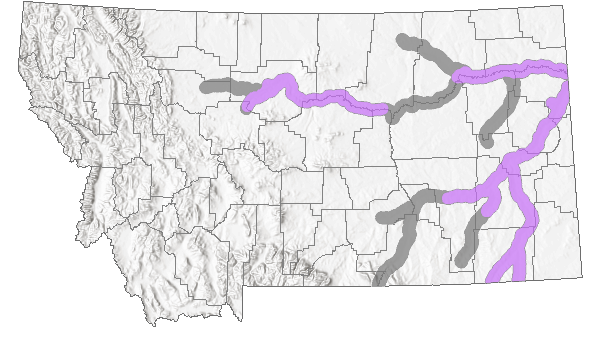 Western Hemisphere Range
Western Hemisphere Range

Range Comments
The sturgeon chub is native to the Missouri-Mississippi river basins from Montana to Louisiana; they were first collected from the Milk River in Montana during the Pacific Railroad Surveys of 1853-1855 (Lee et al.1980; Werdon 1993). The historic distribution included approximately 3,379 km of the main stem Missouri River and ~1,850 km of the Mississippi River, plus the Yellowstone River in Montana and 30 tributaries to the Yellowstone and Missouri rivers (USFWS 2001). The current distribution includes about 1,858 km (55%) of their historical range in the Missouri River and only 11 of 30 tributaries.
Observations in Montana Natural Heritage Program Database
Number of Observations: 181
(Click on the following maps and charts to see full sized version)
Map Help and Descriptions
Relative Density
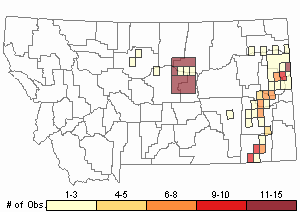
Recency
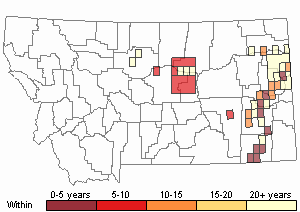
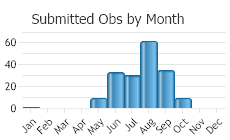
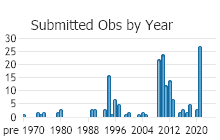
 (Observations spanning multiple months or years are excluded from time charts)
(Observations spanning multiple months or years are excluded from time charts)
Habitat
Sturgeon Chub are found in turbid water with moderate to strong current over bottoms ranging from rocks and gravel to coarse sand (Brown 1971, Holton 1980).
In the Powder River, Sturgeon Chub were taken most frequently at sites with depths less than 51 centimeters and depth velocities of less than 90 centimeters per second at 0.6 depth (Stewart 1981, Werdon 1992, Gould 1997,
Montana AFS Species Status Account).
Food Habits
A Powder River, Wyoming study showed Sturgeon Chub to feed mostly on small invertebrates living on the bottom substrate (Stewart 1980).
Ecology
Sturgeon Chub are often found with Longnose Dace (Morris et al 1981). Young of the year may be associated with a sand bottom. Dam building disrupts required habitat (Stewart 1980).
Average lengths at ages 1 through 3 were calculated to be 48, 69 and 80 millimeters respectively (Werdon 1992). Apparently few fish reach age 4 (Stewart 1981,
Montana AFS Species Status Account).
Reproductive Characteristics
The biology of Sturgeon Chub is not well known. It apparently spawns from June through July (Lee et al. 1980, Stewart 1981, Werdon 1992, Gould 1994). Ripe fish have been found in waters of about 18 to 25 degrees C. (Cross 1967, Werdon 1992, Gould 1994). Sexual maturity is obtained by age 2 at sizes of about 76 millimeters total length (Stewart 1981, Werdon 1992,
Montana AFS Species Status Account). Females produce 2000 to 3500 eggs (Stewart 1980).
Management
December 20th, 2017 the US Fish and Wildlife Service published a notice announcing a substantial finding on the listing petition for this species in the Federal Register (82 FR 60364). On September 20th, 2023 the The U.S. Fish and Wildlife Service published a not-warranted 12-month finding in the
Federal Register .
The management of this species should involve routine monitoring (once every 2 to 3 years) of existing populations. The monitoring program should be designed to evaluate population trends, range expansion or losses and collect additional information on life history and ecology. This could be conducted while sampling for other species. Recommendations for operating reservoir and irrigation projects should be developed for improving and maintaining Sturgeon Chub populations and habitats in Montana. Reintroduction of Sturgeon Chub should be considered for the lower Teton, Milk and Tongue rivers (
Montana AFS Species Status Account).
Stewardship Responsibility
Threats or Limiting Factors
Major threats to the Sturgeon Chub and other large river fishes are habitat and flow alterations from dams, diversions, irrigation operations and riparian development (Rinne et al. 2005). Sturgeon Chubs need gravel riffles and runs in turbid shallow and deeper running waters for their life history requirements (Werdon 1992), thus decreased flows and excessive siltation of gravels are threats facing all lithophilic spawning fish species (Waters 1995). Reservoirs created behind dams inundate riverine habitats and replace the river with lentic conditions, which is unsuitable habitat for Sturgeon Chubs. Dams also create unsuitable habitat for Sturgeon Chubs downstream by reducing turbidities and/or altering temperature and flow regimes (Ruggles, pers. comm). Fortunately for this species, it appears unlikely that any new dams will be built on the Powder, Yellowstone or Missouri rivers in Montana in the foreseeable future. However, water regulation at Fort Peck Dam and several other tributary dams (intake on the Yellowstone) continue to limit the distribution and abundance of some fish populations in Montana by fragmenting populations and restricting spawning and migration patterns (Ruggles, personal communication, Rinne et al. 2005).
References
- Literature Cited AboveLegend:
 View Online Publication
View Online Publication Brown, C.J.D. 1971. Fishes of Montana. Bozeman, MT: Big Sky Books/Montana State University. 207 p.
Brown, C.J.D. 1971. Fishes of Montana. Bozeman, MT: Big Sky Books/Montana State University. 207 p. Cross, F. B. 1967. Handbook of fishes of Kansas. University of Kansas Museum of Nautal History Miscellaneous Publication No. 45. 357 pp.
Cross, F. B. 1967. Handbook of fishes of Kansas. University of Kansas Museum of Nautal History Miscellaneous Publication No. 45. 357 pp. Holton, G. D. 1980. The riddle of existence: fishes of special concern. Montana Outdoors 11(1):2-6.
Holton, G. D. 1980. The riddle of existence: fishes of special concern. Montana Outdoors 11(1):2-6. Lee, D.S., C.R. Gilbert, C.H. Hocutt, R.E. Jenkins, D. E. McAllister, J. R. Stauffer, Jr. 1980. Atlas of North American freshwater fishes. North Carolina State Musuem of Natural History. 867 p.
Lee, D.S., C.R. Gilbert, C.H. Hocutt, R.E. Jenkins, D. E. McAllister, J. R. Stauffer, Jr. 1980. Atlas of North American freshwater fishes. North Carolina State Musuem of Natural History. 867 p. Montana Chapter of the American Fisheries Society species status accounts.
Montana Chapter of the American Fisheries Society species status accounts. Morris, L., T. Hightower, and A. Elser. 1981. An aquatic resources assessment of selected streams in the Lower Yellowstone River Basin. Bureau of Land Management report: YA-512-CT9-52. 151 pp.
Morris, L., T. Hightower, and A. Elser. 1981. An aquatic resources assessment of selected streams in the Lower Yellowstone River Basin. Bureau of Land Management report: YA-512-CT9-52. 151 pp. Pflieger, W. L. 1975. The Fishes of Missouri. Missouri Department of Conservation, Jefferson City. 343 pp.
Pflieger, W. L. 1975. The Fishes of Missouri. Missouri Department of Conservation, Jefferson City. 343 pp. Rinne, J., R. Hughes and B. Calamusso, eds. 2005. Historical changes in large river fish assemblages of the Americas. Published by American Fisheries Society, Bethesda, MD. 612 pp.
Rinne, J., R. Hughes and B. Calamusso, eds. 2005. Historical changes in large river fish assemblages of the Americas. Published by American Fisheries Society, Bethesda, MD. 612 pp. Scott, W.B. and E.J. Crossman. 1973. Rainbow trout, Kamloops trout, Steelhead trout Salmo gairdneri Richardson. pp. 184-191. In: Freshwater fishes of Canada. Ottawa, Canada: Fisheries Research Board of Canada, Bulletin 184. 966 p.
Scott, W.B. and E.J. Crossman. 1973. Rainbow trout, Kamloops trout, Steelhead trout Salmo gairdneri Richardson. pp. 184-191. In: Freshwater fishes of Canada. Ottawa, Canada: Fisheries Research Board of Canada, Bulletin 184. 966 p. Stewart, D.D. 1980. A preliminary study of the life of the biology of the sturgeon chub ( Hybopsis goldia) in the Powder River in Wyoming. Pp 38-41 In: Proceedings of Colorado/Wyoming Chapter, American Fisheries Society Meeting.
Stewart, D.D. 1980. A preliminary study of the life of the biology of the sturgeon chub ( Hybopsis goldia) in the Powder River in Wyoming. Pp 38-41 In: Proceedings of Colorado/Wyoming Chapter, American Fisheries Society Meeting. Stewart, D.D. 1981. The biology of the sturgeon chub (Hybopsis gelida Girard) in Wyoming. Masters thesis. University of Wyoming, Laramie.
Stewart, D.D. 1981. The biology of the sturgeon chub (Hybopsis gelida Girard) in Wyoming. Masters thesis. University of Wyoming, Laramie. Waters, T.F. 1995. Sediment in streams: Sources, biological effects, and control. American Fisheries Society, Bethesda, Maryland. Monograph 7.
Waters, T.F. 1995. Sediment in streams: Sources, biological effects, and control. American Fisheries Society, Bethesda, Maryland. Monograph 7. Werdon, S.J. 1992. Population status and characteristics of Macrhybopsis gelida, Platygobio gracilis and Rhinichthys cataractae in the Missouri River Basin. Masters thesis. South Dakota State University, Brookings, SD. 55 pp.
Werdon, S.J. 1992. Population status and characteristics of Macrhybopsis gelida, Platygobio gracilis and Rhinichthys cataractae in the Missouri River Basin. Masters thesis. South Dakota State University, Brookings, SD. 55 pp.
- Additional ReferencesLegend:
 View Online Publication
View Online Publication
Do you know of a citation we're missing? Bramblett, R.G. 1996. Habitats and movements of pallid and shovelnose sturgeon in the Yellowstone and Missouri Rivers, Montana and North Dakota. Ph.D. Dissertation. Bozeman, MT: Montana State University. 210 p.
Bramblett, R.G. 1996. Habitats and movements of pallid and shovelnose sturgeon in the Yellowstone and Missouri Rivers, Montana and North Dakota. Ph.D. Dissertation. Bozeman, MT: Montana State University. 210 p. Dieterman, D.J., M.P. Ruggles, M.L. Wildhaber, and D.L. Galat (eds). 1996. Population structure and habitat use of benthic fishes along the Missouri and Lower Yellowstone Rivers. 1996 Annual report of Missouri River Benthic Fish Study PD-95-5832 to U.S. Army Corps of Engineers and U.S. Bureau of Reclamation. 238 p.
Dieterman, D.J., M.P. Ruggles, M.L. Wildhaber, and D.L. Galat (eds). 1996. Population structure and habitat use of benthic fishes along the Missouri and Lower Yellowstone Rivers. 1996 Annual report of Missouri River Benthic Fish Study PD-95-5832 to U.S. Army Corps of Engineers and U.S. Bureau of Reclamation. 238 p. Duncan, M.B. 2019. Distributions, abundances, and movements of small, nongame fishes in a large Great Plains river network. Ph.D. Dissertation. Bozeman, MT: Montana State University. 255 p.
Duncan, M.B. 2019. Distributions, abundances, and movements of small, nongame fishes in a large Great Plains river network. Ph.D. Dissertation. Bozeman, MT: Montana State University. 255 p. Gould, W.R. 1997. A summary of information on sturgeon chub in Montana. Intermountain Journal of Sciences 3(4):125-130
Gould, W.R. 1997. A summary of information on sturgeon chub in Montana. Intermountain Journal of Sciences 3(4):125-130 Gould, W.R. 1999. Sturgeon chub (Macrhybopsis gelida) in Montana. 3 p. In: Tews, A., B. Gardner and B. Gardner. Status of Native Fishes of 'Special Concern' in Montana. Unpublished Report on 16 Species.
Gould, W.R. 1999. Sturgeon chub (Macrhybopsis gelida) in Montana. 3 p. In: Tews, A., B. Gardner and B. Gardner. Status of Native Fishes of 'Special Concern' in Montana. Unpublished Report on 16 Species. Joslin, Gayle, and Heidi B. Youmans. 1999. Effects of recreation on Rocky Mountain wildlife: a review for Montana. [Montana]: Montana Chapter of the Wildlife Society.
Joslin, Gayle, and Heidi B. Youmans. 1999. Effects of recreation on Rocky Mountain wildlife: a review for Montana. [Montana]: Montana Chapter of the Wildlife Society. U.S. Fish and Wildlife Service. 1993. Status report on sturgeon chub (Macrhybopsis gelida) a candidate endangered species. Bismark, ND: U.S. fish and Wildlife Service, Ecological Services. 58 p.
U.S. Fish and Wildlife Service. 1993. Status report on sturgeon chub (Macrhybopsis gelida) a candidate endangered species. Bismark, ND: U.S. fish and Wildlife Service, Ecological Services. 58 p. Williams, J.E., J.E. Johnson, D.A. Hendrickson, S. Contreras-Balderas, J.D. Williams, M. Navarro-Mendoza, D.E. McAllister, and J.E. Deacon. 1989. Fishes of North America endangered, threatened, or of special concern: 1989. Fisheries 14(6):2-20.
Williams, J.E., J.E. Johnson, D.A. Hendrickson, S. Contreras-Balderas, J.D. Williams, M. Navarro-Mendoza, D.E. McAllister, and J.E. Deacon. 1989. Fishes of North America endangered, threatened, or of special concern: 1989. Fisheries 14(6):2-20. Wuellner, M.R. 2007. Influence of reach and watershed characteristics on fish distributions in small streams of eastern Montana. M.Sc. Thesis. Bozeman, MT: Montana State University. 80 p.
Wuellner, M.R. 2007. Influence of reach and watershed characteristics on fish distributions in small streams of eastern Montana. M.Sc. Thesis. Bozeman, MT: Montana State University. 80 p. Young, B.A., T.L. Welker, M.L. Wildhaber, C.R. Berry, and D. Scarnecchia (eds). 1997. Population structure and habitat use of benthic fishes along the Missouri and Lower Yellowstone Rivers. 1997 Annual report of Missouri River Benthic Fish Study PD-95-5832 to U.S. Army Corps of Engineers and U.S. Bureau of Reclamation. 207 p.
Young, B.A., T.L. Welker, M.L. Wildhaber, C.R. Berry, and D. Scarnecchia (eds). 1997. Population structure and habitat use of benthic fishes along the Missouri and Lower Yellowstone Rivers. 1997 Annual report of Missouri River Benthic Fish Study PD-95-5832 to U.S. Army Corps of Engineers and U.S. Bureau of Reclamation. 207 p.
- Web Search Engines for Articles on "Sturgeon Chub"
- Additional Sources of Information Related to "Fish"





